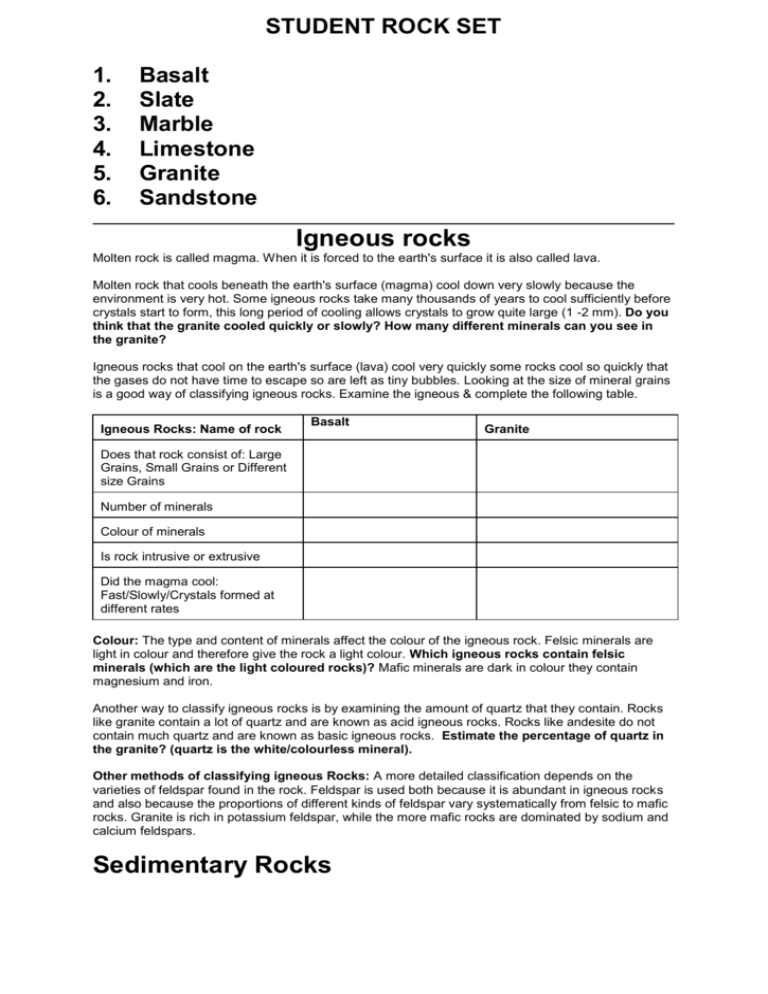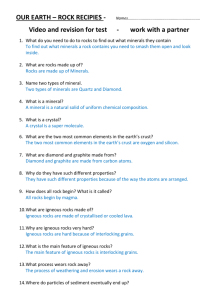Student Rock Set (word)
advertisement

STUDENT ROCK SET 1. 2. 3. 4. 5. 6. Basalt Slate Marble Limestone Granite Sandstone Igneous rocks Molten rock is called magma. When it is forced to the earth's surface it is also called lava. Molten rock that cools beneath the earth's surface (magma) cool down very slowly because the environment is very hot. Some igneous rocks take many thousands of years to cool sufficiently before crystals start to form, this long period of cooling allows crystals to grow quite large (1 -2 mm). Do you think that the granite cooled quickly or slowly? How many different minerals can you see in the granite? Igneous rocks that cool on the earth's surface (lava) cool very quickly some rocks cool so quickly that the gases do not have time to escape so are left as tiny bubbles. Looking at the size of mineral grains is a good way of classifying igneous rocks. Examine the igneous & complete the following table. Igneous Rocks: Name of rock Basalt Granite Does that rock consist of: Large Grains, Small Grains or Different size Grains Number of minerals Colour of minerals Is rock intrusive or extrusive Did the magma cool: Fast/Slowly/Crystals formed at different rates Colour: The type and content of minerals affect the colour of the igneous rock. Felsic minerals are light in colour and therefore give the rock a light colour. Which igneous rocks contain felsic minerals (which are the light coloured rocks)? Mafic minerals are dark in colour they contain magnesium and iron. Another way to classify igneous rocks is by examining the amount of quartz that they contain. Rocks like granite contain a lot of quartz and are known as acid igneous rocks. Rocks like andesite do not contain much quartz and are known as basic igneous rocks. Estimate the percentage of quartz in the granite? (quartz is the white/colourless mineral). Other methods of classifying igneous Rocks: A more detailed classification depends on the varieties of feldspar found in the rock. Feldspar is used both because it is abundant in igneous rocks and also because the proportions of different kinds of feldspar vary systematically from felsic to mafic rocks. Granite is rich in potassium feldspar, while the more mafic rocks are dominated by sodium and calcium feldspars. Sedimentary Rocks The effects of weathering constantly breaks down the igneous, metamorphic and sedimentary rocks to produce a supply of rock fragments known as sediment. Sediment is then transported by rivers, ice, wind and sea and deposited into layers. Compacting and cementing of Sediments: As the layers of sediment become buried under new deposits the increasing pressure of the new layers compacts the sediment. Rock grains are pushed together and water between the grains is pushed out depositing the minerals that the water was carrying as a thin layer on the surface of the sediment. This acts as cement and the sedimentary rock is formed. Classifying Sedimentary Rocks: Mineralogy and texture are also useful in subdividing the sedimentary rocks. They are used in combination to set apart two main groups, the detrital and the chemical. The detrital sediments are those that have been mechanically transported before becoming sedimentary rocks and the chemical sedimentary rocks are those that have precipitated directly out from sea water. Limestones: If the sediment consists mainly of shell fragments or the mineral calcium carbonate ( the mineral that shells are made from) the resulting sedimentary rock is called limestone. An easy test for limestone is that it fizzes when dilute Hcl acid is dropped onto it. Oolitic limestones formed during the Jurassic period. Small grains of sand were blown along a pre-historic beach gradually building up layers of calcium carbonate, the tiny spheres bonded together to form an Oolitic Limesto ne. Sandstone: Carried by rivers the boulders and pebbles often settle out first concentrating sediment of the same size in one layer. The boulders form a layer that becomes a breccia, if they have travelled far by river they become rounded and form conglomerate, the sandy material forms sandstone and the fine clay and silt settle out to form marls and mudstones or if they form distinct layers: shale forms. Metamorphic Rocks Metamorphism is the process by which an existing rock is changed through the action of heat and pressure. Examine the marble and slate which one has undergone heat and pressure? Which one has undergone just heat? The change in the rock depends on the amount of heat and the amount of pressure. A good example of how a metamorphic rock forms is the change from limestone to marble. The mineral called calcium carbonate in the limestone recrystallises when heated to form the characteristic white marble Sedimentary Rock Metamorphism Metamorphic Rock Characteristics Limestone Heat Marble Interlocking crystals Shale Heat and Pressure Gneiss Parallel sheets or bands On further heating new minerals may start to form. Look at the garnet gneiss. Can you see small red crystals? These are garnets, garnets only form at temperatures of over 750 DEG C. If higher temperatures are reached the whole rock melts and is then classified as an igneous rock such as granite. Magma rises from inside the earth to form igneous rocks, these rocks are gradually broken down to form sediment which becomes cemented forming Sedimentary rocks. The Sedimentary rocks are buried under other rocks and heated with pressure to become metamorphic rocks. If they are heated to a point where they melt they become magma and rise to the surface to become igneous rocks, and so on. The complete cycle takes many millions of years to complete.








